|

GW Realizes Impact of Centuries Campaign Success | Public Policy School Opens |
Board Approves Fixed Tuition | The Progress of Business | Designing Women |
Physics Honors | Let the Games Begin | George Welcomes | At a Glance

GW Realizes Impact of Centuries Campaign Success
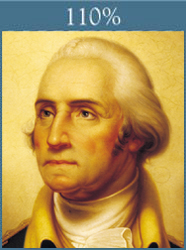 More than 10 years ago, GW kicked off the Centuries Campaign, the second capital campaign in the history of the University. Now in 2004, one year after the campaign was successfully completed, the GW community is enjoying the benefits—new buildings, expanded learning programs, scholarships and fellowships, chairs and professorships, and stronger overall operations. Designed to raise $500 million in a decade, the Centuries Campaign met that goal nine months ahead of schedule and exceeded the mark by the end of June 2003, bringing in $552 million from alumni, parents, trustees, friends, faculty and staff members, and national corporations and foundations. More than 10 years ago, GW kicked off the Centuries Campaign, the second capital campaign in the history of the University. Now in 2004, one year after the campaign was successfully completed, the GW community is enjoying the benefits—new buildings, expanded learning programs, scholarships and fellowships, chairs and professorships, and stronger overall operations. Designed to raise $500 million in a decade, the Centuries Campaign met that goal nine months ahead of schedule and exceeded the mark by the end of June 2003, bringing in $552 million from alumni, parents, trustees, friends, faculty and staff members, and national corporations and foundations.
At the start of a new century, GW is now a campus transformed, in part because of the success of the campaign. A new mid-campus quad; the technologically advanced Media and Public Affairs Building—from which CNN’s Crossfire airs live five days a week; the Theodore and Annette Lerner Family Health and Wellness Center; renovations and additions to the Law School and the Marvin Center; and a shared new home for the Elliott School of International Affairs, the Geography Department, and the Executive Education Programs are all visible benefits of the Centuries Campaign. A highlight of these individual donations is the $5 million gift from Ric Duques, BBA ’65, MBA ’69, and Dawn Duques, BA ’69, that completed the building fund drive for the School of Business.
The University has become increasingly stronger in competition for gifts and grants from national corporations and foundations, including the Howard Hughes Medical Institute, MSNBC.com, Hyundai and Kia Motors, and the MacArthur Foundation. Funding from these and other corporations and foundations have helped GW establish research and learning programs including an automotive safety research lab and a security space forum, and opportunities in innovative areas such as bioinformatics and computational molecular biology.
Twenty-nine percent of the Centuries Campaign total was committed to the endowment. More than 390 new endowed funds, including 170 scholarships and fellowships, more than 30 chairs and professorships, and 125 funds for designated schools and departments are being established to strengthen GW’s faculty leadership and academic programs. Two of the largest commitments for endowment in the last year of the campaign came from faculty members.
The results of the campaign show a steady increase in donations every year, with more than $131 million—nearly 24 percent of the overall total—being gifted in its last two years. The annual level of private gift support also continues to grow. And the campaign attracted more givers to the University than ever before—since the beginning of the campaign, more than 3,000 new contributors have joined the ranks of GW supporters.
Public Policy School Opens
The School of Public Policy and Public Administration was inaugurated Jan. 21. The school was formed by merging the Department of Public Administration from the School of Business with graduate programs in the Columbian College of Arts and Sciences.
GW President Stephen Joel Trachtenberg—a professor of public administration and a member of the school’s faculty—says the new school showcases some of the University’s strengths.
“Since GW is located in a city that is home not only to the nation’s government but also to the nation’s policy process, it seemed only natural to create a School of Public Policy and Public Administration,” Trachtenberg says. “It brings together public policy resources that have been spread across the University and centralizes, consolidates, and leverages the talents of faculty and the enthusiasm of students to create a first-class center of scholarly excellence.”
Kathy Newcomer is the school’s director and a professor of public policy and public administration. “This move presents a more unified picture to the public and increases our visibility to students and our competitors,” she says.
Public policy and administration study fosters critical thinking, analysis, and research skills to prepare students for opportunities in varied fields such as government service, public and private businesses, nonprofit organizations, and community advocacy groups.
To meet the needs of their students, faculty members offer widespread expertise. In addition to public policy and public administration professors, faculty members include economists, political scientists, historians, and sociologists.
This area of study has attracted a growing number of students at GW. Now a school within the Columbian College, the School of Public Policy and Public Administration has received increased funding for more graduate assistants, policy research scholars, and a research grants manager.
|
Board Approves Fixed Tuition

The Progress of Business
Construction of the business school’s new home, Duques Hall, on 22nd Street between G and H Streets, is well under way. To view real-time images of the construction progress, visit www.gwu.edu/
~sbpm/about/building/buildingcam.htm.
|
The George Washington University Board of Trustees approved a new fixed-rate tuition plan for incoming freshmen that will provide cost certainty for families and guarantee a minimum level of financial assistance for students awarded merit and need-based institutional aid at the time of enrollment.
“These are challenging times for institutions of higher education, both public and private,” says President Stephen Joel Trachtenberg. “Our mission is to provide a first-rate education to our students and that means first-rate faculty, state-of-the-art classrooms, and a living and learning environment that supports a healthy overall experience.
“At the same time, we are compelled to hold down costs, pay our bills and plan for the future,” Trachtenberg says. “So, we need to be more imaginative in determining how best to meet our needs and serve our constituencies. This family-friendly initiative takes the mystery out of tuition prices, guarantees institutional aid and helps both GW and our families plan for today and tomorrow.”
Tuition increases at private universities last year averaged 6.3 percent, and the economy continues to make pricing unpredictable. The new plan keeps tuition costs consistent for four years (plus a possible fifth year for those students who need it) and guarantees a minimum level of institutional financial aid during a student’s undergraduate enrollment.
For incoming freshmen in the 2004-05 year, tuition—which will be frozen for their entire undergraduate experience, up to five years—will be $34,000. There will be no further tuition increase for their sophomore, junior, and senior years. The increase equates to less than 4 percent a year. Room and food prices will continue to be subject to normal inflationary pressures.
Also in the coming academic year, funding for undergraduate and graduate student financial assistance will increase by about $14 million, bringing the University’s total commitment for student aid to more than $123 million. Under the fixed-price plan, freshmen who receive institutional financial aid can rely on a defined minimum amount of aid throughout their four- or five-year enrollment, as long as they continue to make satisfactory academic progress.
As part of the new tuition plan, increased funds will be dedicated to initiatives related to GW’s Strategic Plan to bolster academic excellence, including the new Writing Program, facilities investment, and graduate aid and support for Gelman Library and GW Law School. Increased allocations also will be made to enhance services such as campus safety and security, student life, administrative research support, and customer service.
The fixed-rate tuition plan begins with new, full-time students entering in fall 2004.

Freshman Class Raises the Bar
The current freshman class is the most selectively admitted and most academically qualified in University history, according to statistics from the admissions department.
Thirty-eight percent of applicants for the Class of 2007 were admitted. That number is 10 percentage better than two years ago, and 20 percentage points better than a decade ago (see chart).
GW received 18,442 applications last year for its current class of 2,266 enrolled freshmen, which came from a group of 7,103 prospective students who were granted admission.
“D.C. is attractive to our applicants, but what we offer as an institution is the real attraction. Without a strong product, the rest of it wouldn’t happen,” says Kathryn Napper, director of admissions.
Average SAT scores of the freshman class rose 15 points from the last academic year to 640 in both verbal and math.
Another mark the University is proud of is its freshman retention rate. Fred Siegel, associate vice president and dean of freshmen, says the rate is about 92 percent, and he is aiming to improve it to 95 percent.
“The most important thing for a freshman is a connection to something,” Siegel says. “It may be a part-time job, rushing a greek organization, or an internship, but there has to be some connection to supplement the academics.”
Online resources have become increasingly important in the recruitment process. While Napper says the best recruiting tool continues to be a campus visit where prospective students spend one-on-one time with admissions representatives, the admissions office increasingly relies on e-mail and Web site communications.
Napper says as the admissions process continues for this coming fall, she is encouraged by early signs of success.
“It’s still preliminary, but all of the indicators, in terms of visits this summer, the in-depth questions we’re getting early in the process and positive feedback from high school counselors, show that we are headed in a strong position for the coming year,” Napper says.
Another promising sign for continued admissions success is the new record set in February, when GW hit the 20,000 applications mark, breaking the previous year’s record of 18,569. This year’s applications more than double the 9,681 applications of a decade ago.
—Greg Licamele

Designing Women
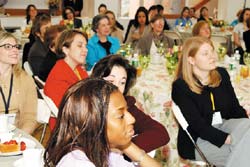
Members of GW’s Columbian Women joined current students, alumnae, and faculty and staff members for the conference events. Photo Claire Duggan
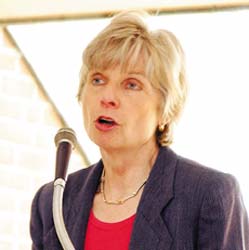
Newsweek Contributing Editor Eleanor Clift
|
To educate and inspire women, Elizabeth Somers founded Mount Vernon Seminary and College, now GW’s Mount Vernon Campus, in 1875. Honoring that tradition, the campus is a fitting location for the annual Women’s Leadership Conference, designed to help women develop career, time management, leadership, and relaxation skills. Held in March, this year’s event offered workshops, a luncheon keynote address by Newsweek Contributing Editor Eleanor Clift, individual career consulting, and a panel discussion.
The seven workshops, led by faculty and staff members, graduates, and women entrepreneurs were on topics as varied as salary negotiation and dealing with physical stress. Common themes emerged from the sessions, such as the value of setting specific goals, honoring personal time, and “growing a backbone.”
During her keynote address, Clift spoke about journalism, women in politics, and the suffragettes whose lives she recounts in her new book, Founding Sisters and the Nineteenth Amendment. As the only female regular panelist on “The McLaughlin Group,” Clift forged a path for herself in the predominately male political arena.
Adjunct Professor in Counseling and Human Services Victoria A. Sardi, MA ’96, PhD ’03, facilitated a panel discussion titled “Being in Total Control of Herself” by Cissy Baker, a 1978 Mount Vernon College graduate and GW Board of Trustees member who helped to launch CNN in the early’80s and who now is corporate vice president of news and Washington bureau chief of Tribune Broadcasting; Corriece Perkins Gwynn, publisher and editor-in-chief of Homes of Color magazine; School of Business Dean Susan Phillips; and Francine Zorn Trachtenberg, a consultant and former senior administrator at Washington’s public broadcasting station, WETA TV & FM.
—Laura Ewald

Physics Honors
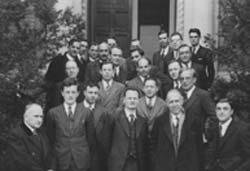
Professors George Gamow and Edward Teller helped establish the Washington Conferences on Theoretical Physics. In 1939, Niels Bohr made the first announcement of the fission of uranium at one of those meetings in GW’s Hall of Government. Shown are the scientists who attended the Third Washington Conference on Theoretical Physics in 1937. Pictured front row center is Hans Bethe. To the right are I.I. Rabi, Niels Bohr, and Felix Bloch. Behind Bohr to the right is George Gamow. In the center and toward the back, partially hidden, is Edward Teller.
|
The field of physics advanced by two revolutions in the 20th century: Einstein’s relativity theory and the quantum theory of matter. Accordingly, former President Cloyd Hecht Marvin strengthened physics at GW by hiring prominent theorists Edward Teller and George Gamow.
Gamow became famous for proposing the Hot Big Bang Theory of the universe. He was honored by GW in 2002 with a plaque in front of Samson Hall.
Now, after his death in 2003, Teller’s early work at GW is celebrated with a plaque mounted at the entrance of the chemistry and physics building, Corcoran Hall.
Teller, now best known for his work on the hydrogen bomb, came to GW in 1935, lecturing on quantum theory and conducting research as a chemical physicist. He helped to produce several seminal papers in chemical and nuclear physics, including molecular adsorption on surfaces, shapes of molecules, spin-induced radioactive decay, neutron stars, nebulae formation, and energy production in red giants. During his lifetime, he received the Enrico Fermi Award from President John F. Kennedy and the National Medal of Science from President Ronald Regan.
Teller and Gamow’s efforts led to the establishment of the Washington Conferences on Theoretical Physics, where in 1939, Niels Bohr made the first announcement of the fission of uranium in GW’s Hall of Gover-nment. A second plaque commemorates this announcement by Bohr of the Atomic Age. The text of this and the Teller plaque were composed by Physics Professor and Chairman William Carleton Parke, who knew both Teller and Gamow.
Teller’s research and the lasting impression he left on GW are far-reaching, Parke says. As Parke wrote in the plaque, “His colleagues remember the precise, profound, and prodigious character of Edward’s mind.”

Let the Games Begin
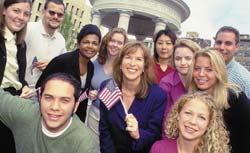
Delpy Neirotti (center) with some of her former students. Photo Joanne Lawton
|
She’s gone to every Olympic Games for the past two decades, but Lisa Delpy Neirotti doesn’t measure her success in gold medals. One of the world’s foremost Olympic scholars, the GW associate professor of tourism and sport management stands on a different type of podium at the international mega-event. This August, she will be leading her seventh group of GW business students to the Olympics for a comprehensive, behind-the-scenes look at organizing, marketing, and hosting the Games.
Since joining GW’s faculty in 1991, Delpy Neirotti has placed GW firmly on the international sports management map. “I was brought here to establish a sports management program and have been growing it ever since,” she says, noting that some 100 undergraduate and graduate students are currently enrolled in the program.
Several months after arriving at GW, she organized the University’s first trip to the Olympics in Barcelona, followed by Lillehammer (1994), Atlanta (1996), Nagano (1998), Sydney (2000), and Salt Lake City (2002). The two-week Olympic on-site visit is the culmination of a unique semester-long course, “Behind the Scenes at the Olympic Games,” created and taught by Delpy Neirotti.
“Students go behind the scenes to learn about the organizational infrastructure, management, integrated marketing, and socio-economic impact of the Games,” she says. At the Games, students meet with top-level Olympic officials, administrators, corporate sponsors, and athletes, and have the opportunity to conduct on-site marketing research on topics such as spectator spending and motivation.
“I realized through my own great learning experiences at the Olympic Games how important it was to experience this mega-event first hand, so I brought it to George Washington,” she says. “The trip not only reinforces material learned in the classroom, but allows students to network and make valuable connections for the future.”
Delpy Neirotti’s career-long involvement with the Olympics began in 1983 as a student intern at the U.S. Olympic Training Center in Colorado Springs, Colo., where she worked in the exercise physiology lab, testing athletes such as Carl Lewis. “One of my responsibilities was taking VIPs and sponsors on tours of the facility, and I soon realized that I enjoyed the business and sports marketing side of things more than exercise science,” she says. That feeling was cemented in 1984, when Delpy Neirotti volunteered at the Winter Games in Sarajevo and the Summer Games in Los Angeles and loved every minute of it.
After earning her bachelor’s degree in physical education at California Polytechnic State University in 1985 and her master’s degree in sport management from George Mason University in 1988, she spent two years traveling the globe researching the development and organization of the Olympic movement. “I visited 56 countries from 1988 to 1990, interviewing and videotaping more than 200 Olympic officials, coaches, and athletes,” she says.
Since earning her PhD in sport administration from the University of New Mexico in 1991, Delpy Neirotti has devoted her career to sharing her expertise. “The students come in so excited, and it’s fun to see them break into and succeed in this very competitive field,” she says.
The Olympics course is just one program created by Delpy Neirotti. In non-Olympic years, she takes groups of students to destinations such as Cuba, Costa Rica, and Belize to study adventure tourism and sustainable tourism development. Throughout the year, she arranges for prominent guest speakers and organizes special campus events and conferences. She is founder and program director of the annual TEAMS: Travel, Events, and Management in Sports conference and a consultant to various sports organizations. She also co-authored The Ultimate Guide to Sport Event Management and Marketing (McGraw-Hill, 1995; 2nd ed., 2001) and is a sought-after speaker.
Known for her open door and her ongoing ties with program alumni, Delpy Neirotti maintains an extensive listserv for current and former students, in which she broadcasts various career opportunities. “I have a wide network, since I’ve been in the business so long,” she says.
She’s quick to state that her students have done very well. “They can be found in top sports organizations throughout the country—the U.S. Olympic committee, NBA, NFL, NHL, SFX Sports, NIKE, sports marketing agencies, and ESPN, to name a few,” she says. “I keep in touch with many of them, and enjoy seeing them progress. It’s been a great run.”
—Jamie L. Freedman
|
|